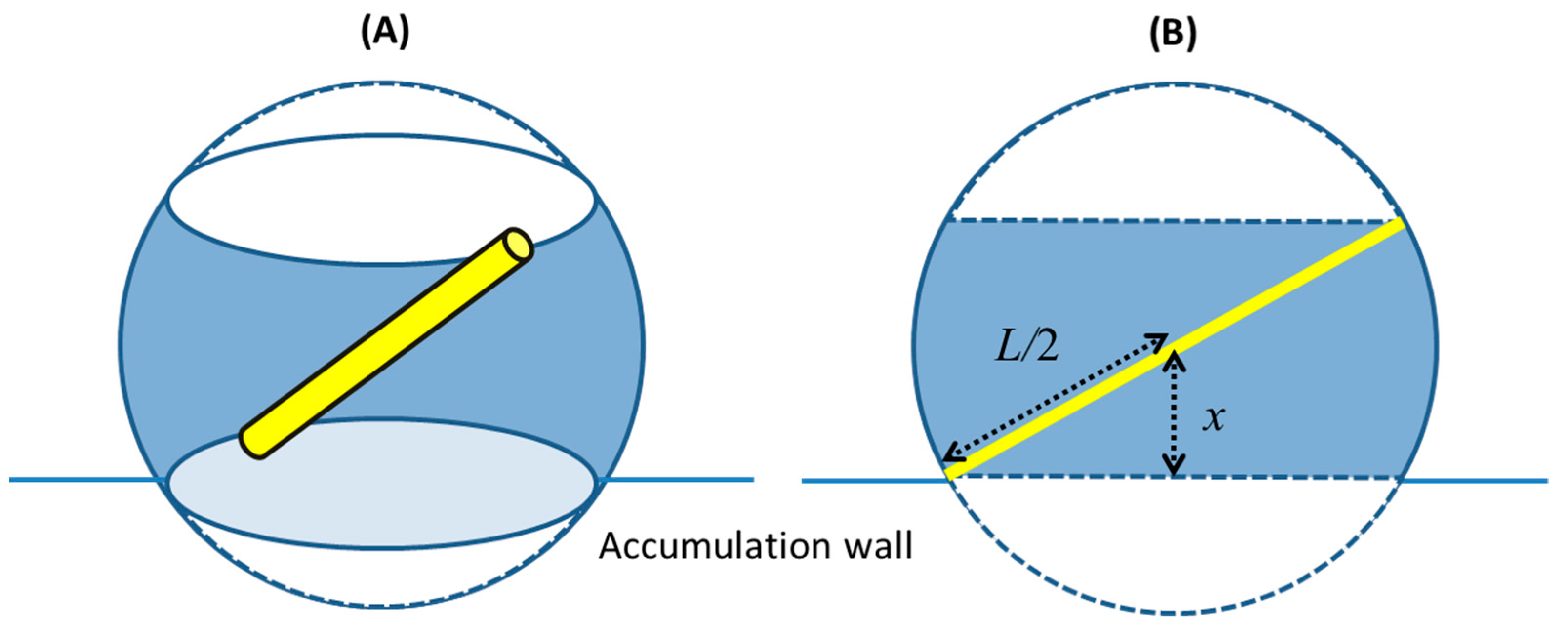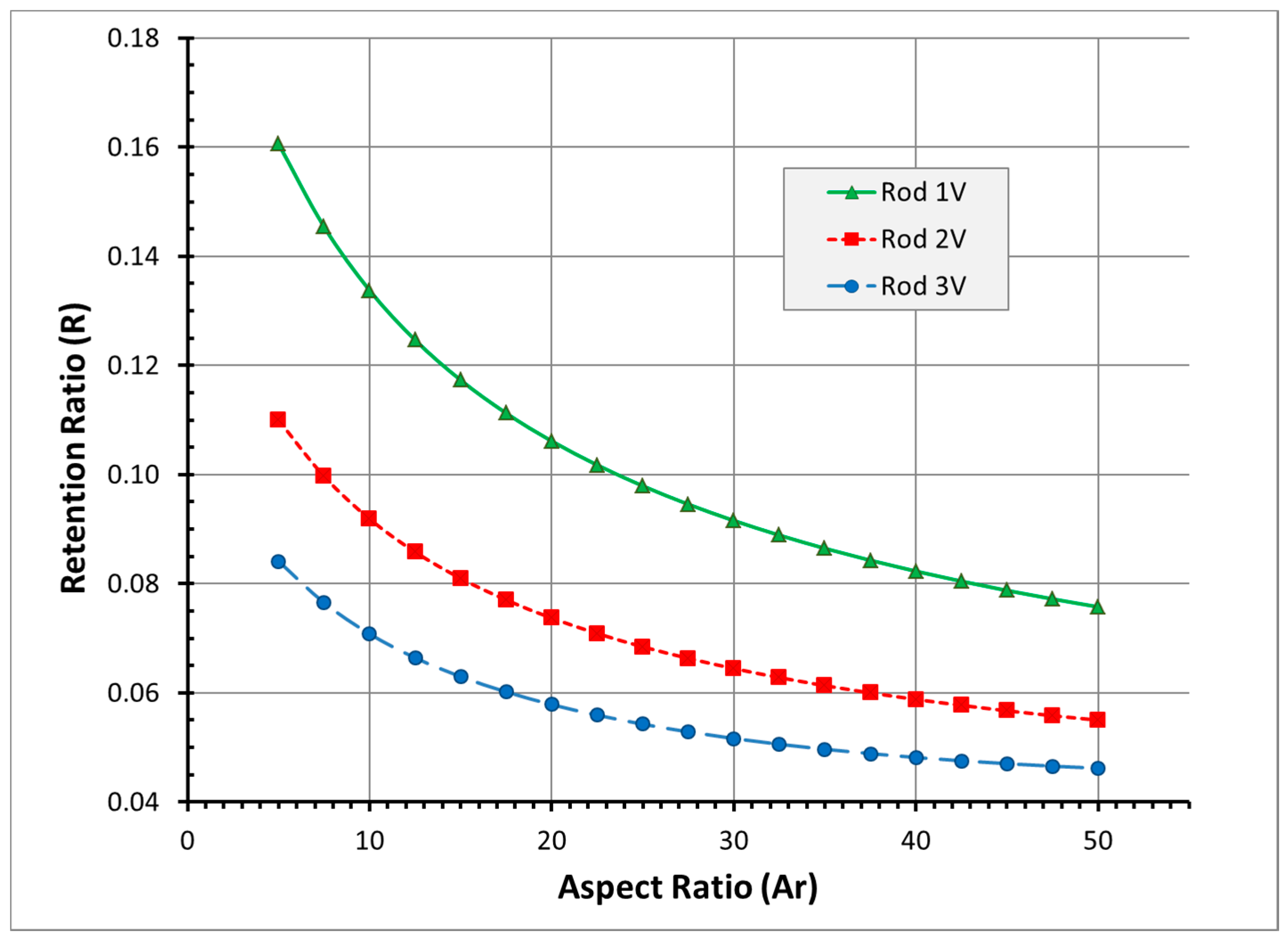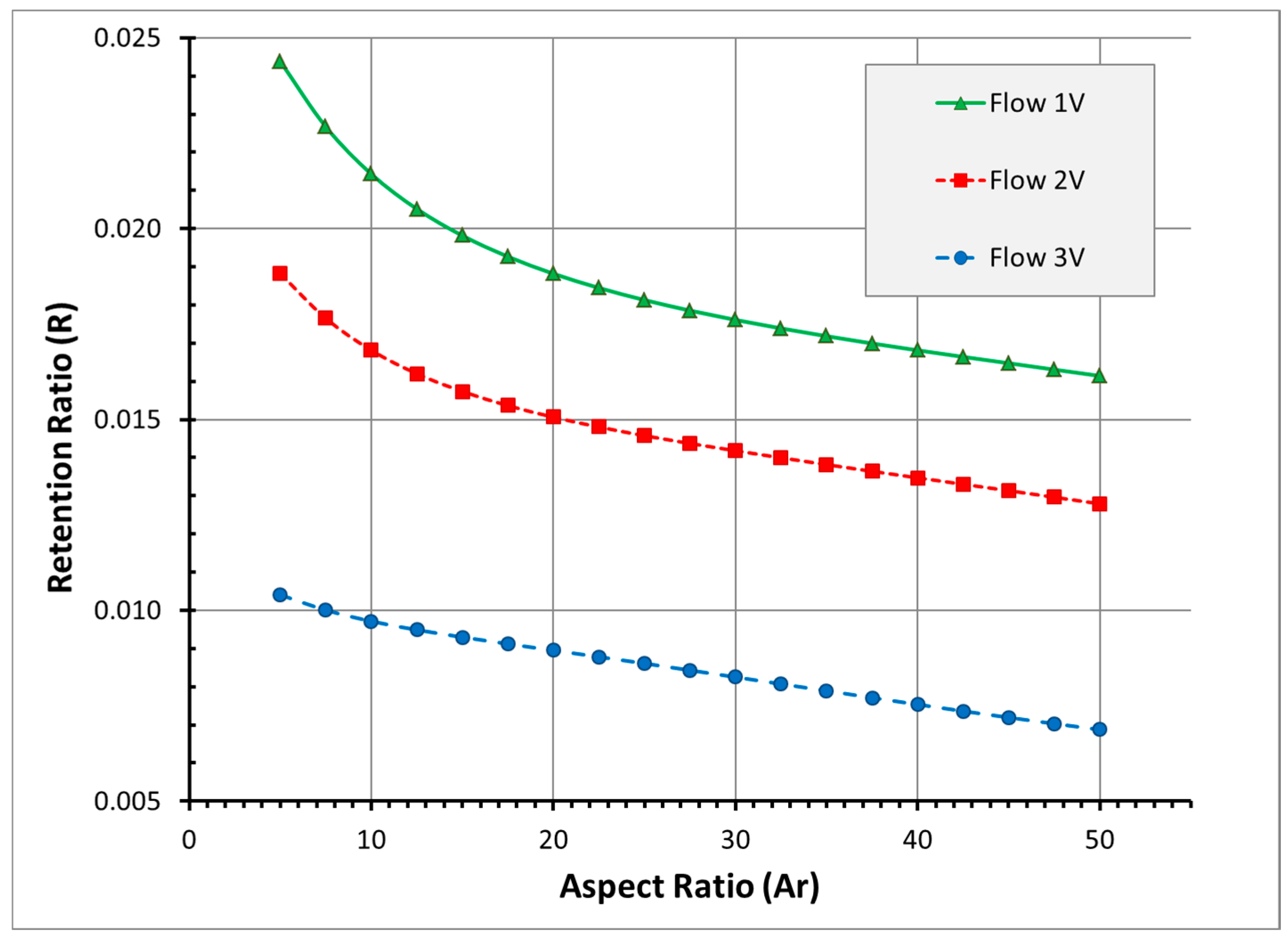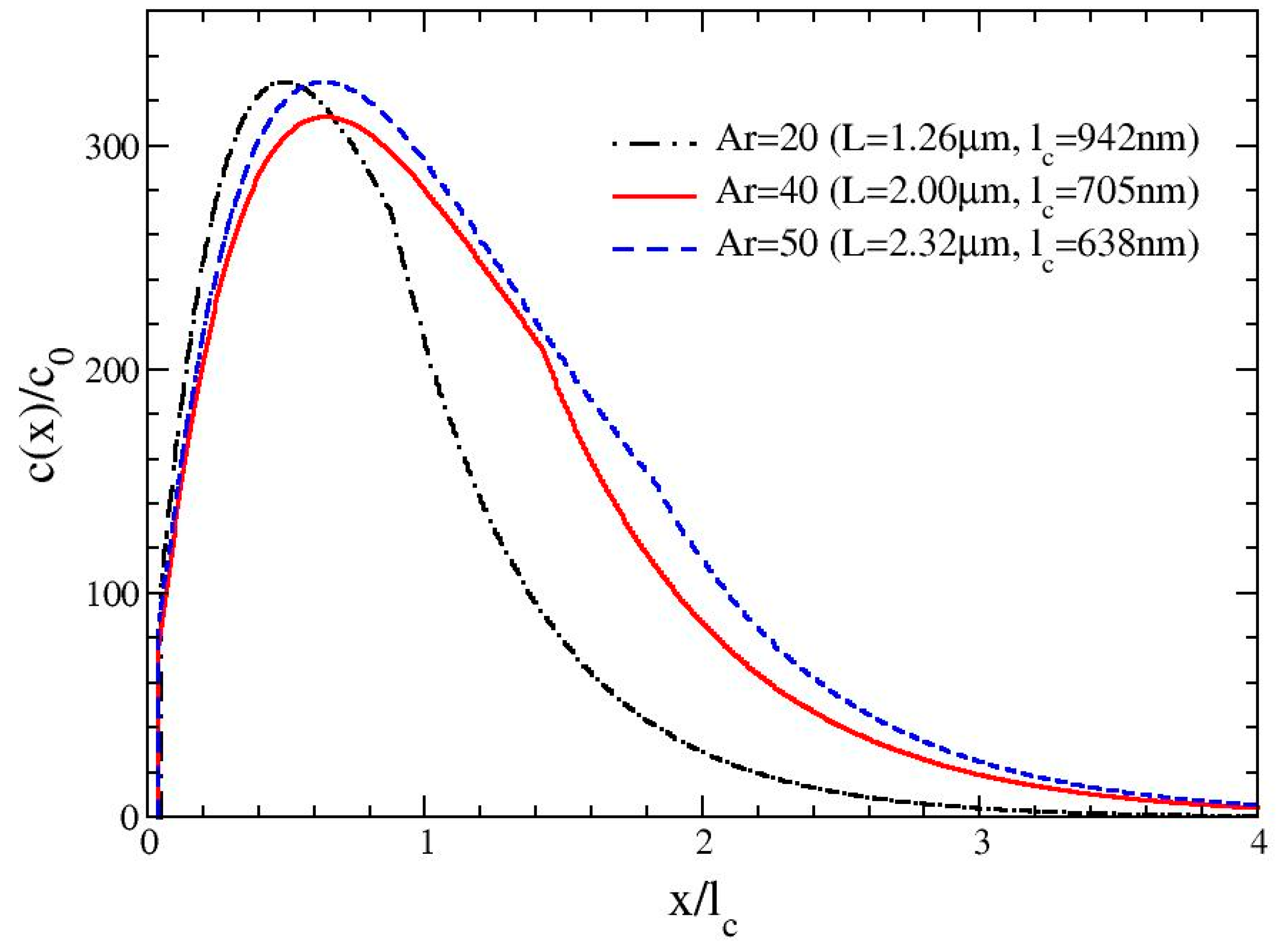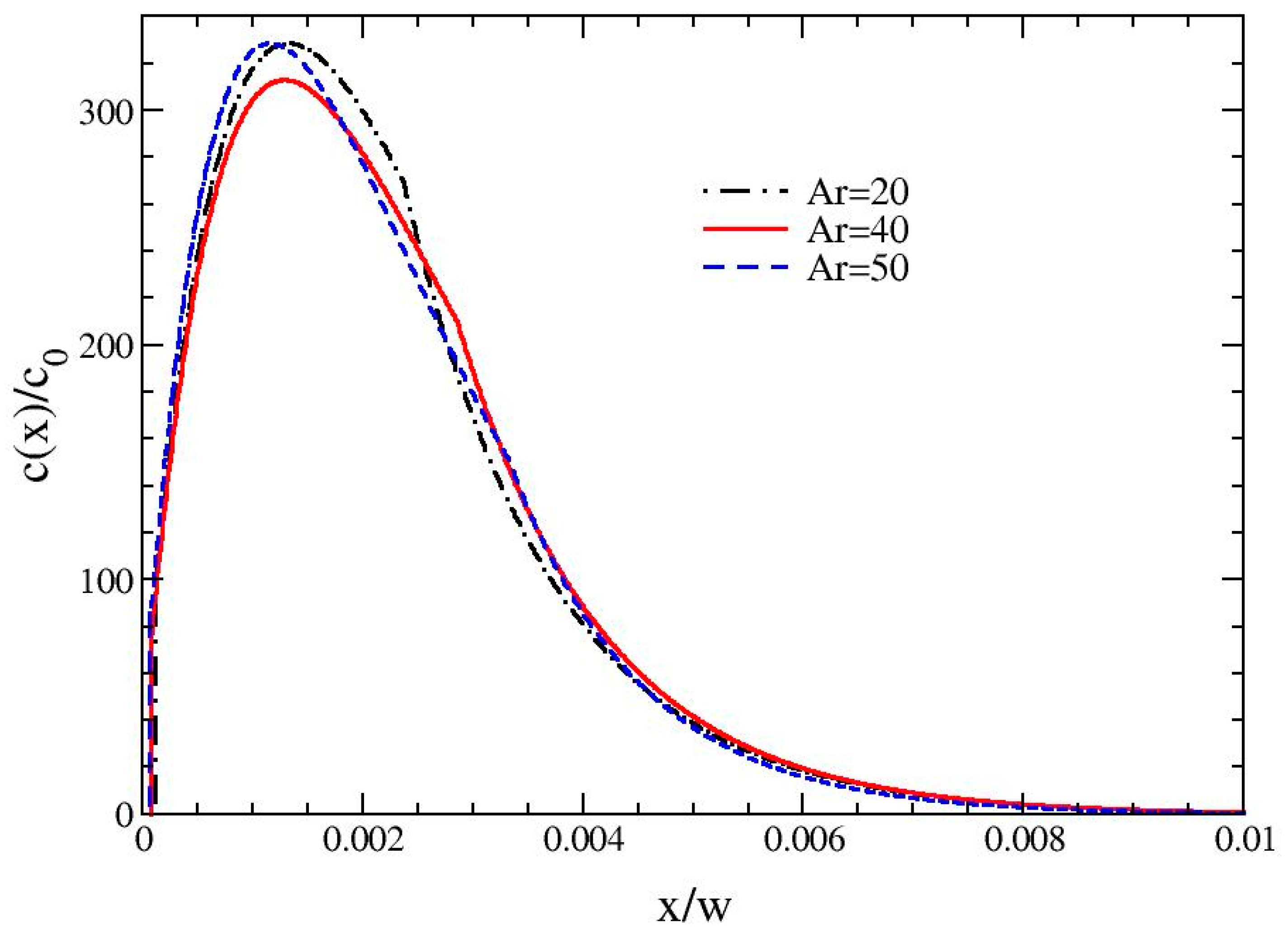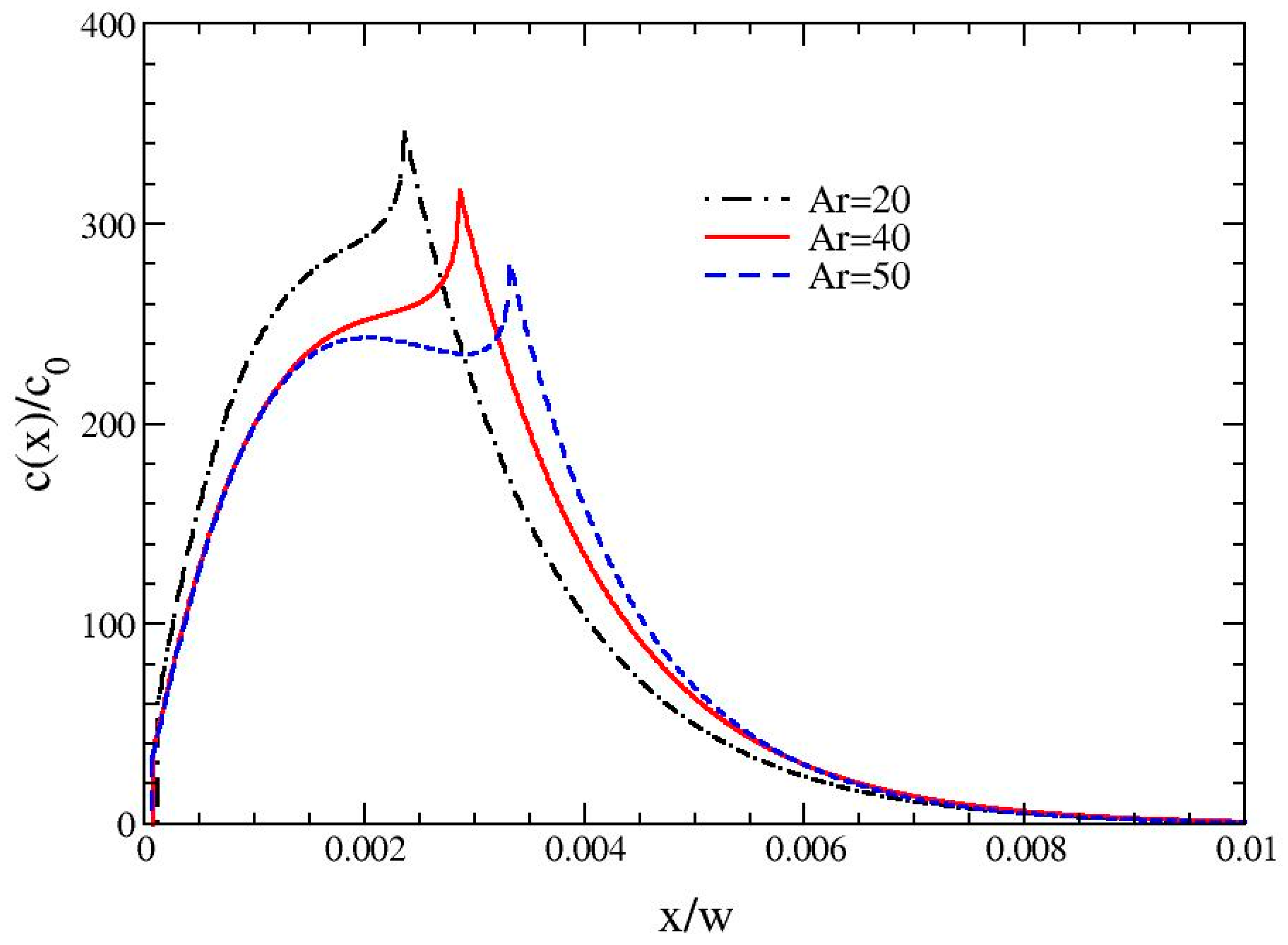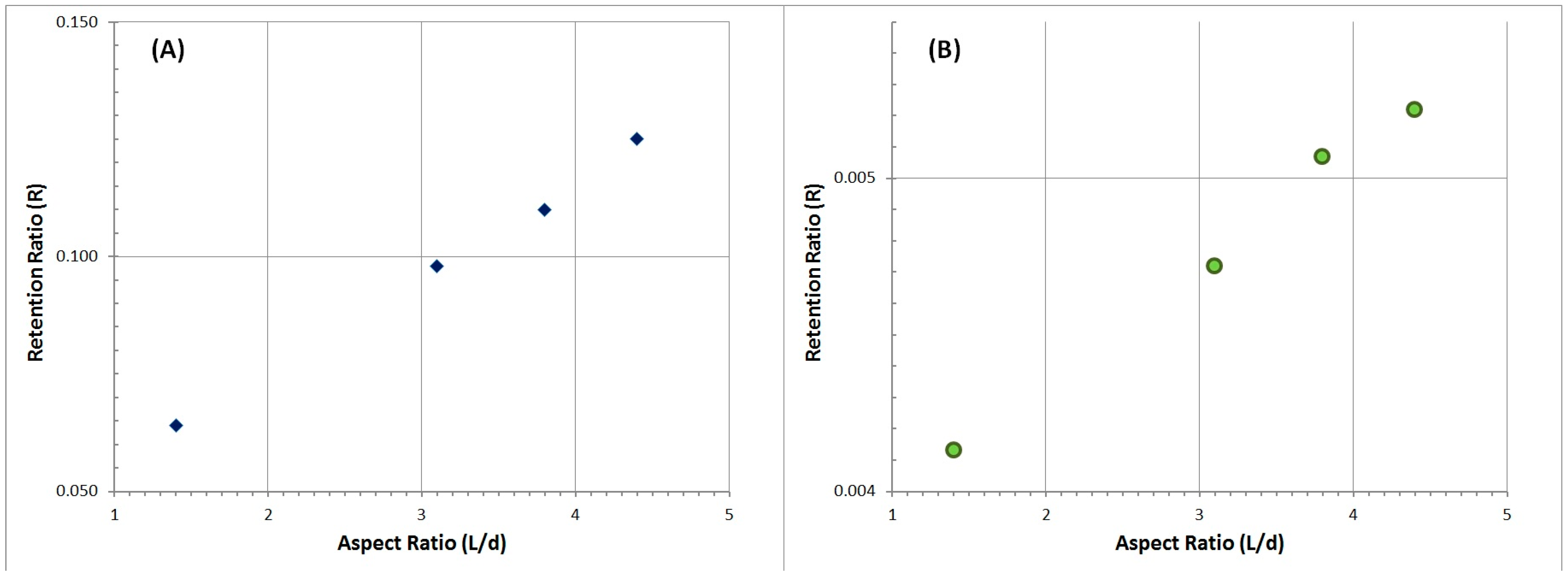1. Introduction
Field-flow fractionation (FFF) is a particle separation technique which utilizes a parabolic channel flow and a cross-force field. As particles are flowing in the channel flow, the cross force pushes them towards the bottom of the channel (“accumulation wall”). However, the particles form a concentration distribution in the cross-sectional direction near the wall according to their physical properties in response to the force field. Thus, particle mixtures with different physical properties result in different concentration distributions and subsequently a different elution time due to the parabolic channel flow. In other words, particles whose concentrations are distributed farther away from the wall tend to elute faster. Therefore, correctly modeling the concentration distribution by incorporating the response of a particle of interest to a particular force field is a key to predicting the separation behaviors of particles in FFF. Based on the types of responsive forces, separation mechanisms in FFF are classified as “normal mode” for particle diffusivity, “steric mode” for excluded volume effect, and “lift-hyperlayer mode” for shear-induced migration [
1].
Shape-based particle separation using FFF has gained attention due to the rapid development in the applications of micro/nanorods, in which shape-specific physico-chemical properties are important. Examples can be found in biomedical applications of gold nanorods (GNR) [
2] and polystyrene (PS) rods [
3,
4], where the aspect ratio (the ratio between the length of the long principal axis and the diameter of a rod-like particle:
Ar =
L/
d) characterizes the property utilized. Our interest in this work is focused on the dynamics of rod-like particles in flow-FFF (Fl-FFF), in which the cross-force field is the flow field. For the sake of clarity and convenience, FFF, throughout the rest of this study, will be referred to as Fl-FFF.
The majority of theories about FFF has been developed based on the assumption that particles are spherical in shape. Studies on the shape effect of non-spherical particles on FFF separation have been limited. Beckett and Giddings proposed a separation mechanism called the “steric-entropic mode,” which considers the shape effects of rod and disk-like particles on the cross-sectional concentration distribution very near the accumulation wall [
5]. The numerical simulation performed by Phelan and Bauer compared the normal and steric modes of rod-like particles and spherical particles [
6]. Alfi and Park developed a model that can predict the concentration distribution of rod-like particles by considering the average orientation correction for the normal mode as well as the shear-induced rod migration for the lift-hyperlayer mode [
7].
Experimental studies on rod-like particle separation have been performed on single-walled carbon nanotubes (SWNT) and GNRs. Chun and coworkers separated SWNTs according to their lengths. The lengths of SWNTs were estimated by comparing the elution times of polystyrene spherical particles of known sizes and light-scattering data [
8]. The separation of GNRs has been performed for various sizes and shapes using asymmetric flow FFF (AF4), which is a commercialized variation of Fl-FFF [
9,
10,
11]. Although experimental results have shown many examples of separation by sizes and shapes, theoretical explanation of those experimental observations has yet to be elucidated. One noteworthy experimental observation is the
Ar-based separation by Gigault and coworkers [
9]: The results of GNR elution times showed that higher
Ar rods elute faster. However, this
Ar-enhanced elution trend cannot be explained by the normal mode, whether based on typical FFF theory or the recent model for rod-like particles [
7], which will be demonstrated and discussed in later sections. Although Gigault and coworkers discussed the
Ar-enhanced elution by referring to the steric-entropic mode, no quantitative or qualitative analysis using the concentration distribution of the steric-entropic mode has yet been performed [
9].
Based on the theory of the steric-entropic mode, the orientation distribution of a non-spherical particle is restricted by the excluded volume effect caused by the interplay between the particle configuration and the accumulation wall, which results in entropy loss and subsequent faster elution (
Figure 1). The equation for the derived cross-sectional concentration distribution,
c(
x), for rod-like particles is given as
Here,
c0 is the particle concentration at the wall (
x = 0) and
lc is the cloud thickness which can be expressed as
lc =
D⊥/
Ux for a rod with a translational diffusivity in the perpendicular direction to its long axis,
D⊥, under the cross-flow field of flow rate
Ux. Equation (1) predicts that increasing values of
L/2
lc will lift
c(
x) away from a wall for the condition of
L > 2
lc >
d, where
lc is assumed to be constant (see
Figure 2 of [
5]) . In other words, it suggests that rods with longer
L should show the
Ar-enhanced elution, as discussed in [
9].
Figure 1.
(
A) A schematic demonstration of the restricted orientation configuration (shaded region on the sphere) of a Brownian rod with length
L and its center-of-mass position at
x. (
B) the same demonstration in the
z-direction view (redrawn from [
5]).
Figure 1.
(
A) A schematic demonstration of the restricted orientation configuration (shaded region on the sphere) of a Brownian rod with length
L and its center-of-mass position at
x. (
B) the same demonstration in the
z-direction view (redrawn from [
5]).
In this study, we investigated the
Ar-dependent separation trend by applying the steric-entropic mode to the model equation for
c(
x) developed by [
7]. It is important to note here that we released the constant
lc assumption by actually evaluating it for each
D⊥/
Ux. The results from our analysis did not find the
Ar-enhanced elution under any flow conditions. Therefore, we propose an improved mechanism for the steric-entropic mode that identifies some cases reproducing the
Ar-enhanced elution trend. This study is organized as follows:
Section 2 describes the mathematical models and numerical calculations used;
Section 3 demonstrates the results of each model and discusses the
Ar-dependent trend by comparing those results to each other;
Section 4 summarizes the findings and future works.
2. Model Description
In this study, we analyze the separation behaviors of rod-like particles in FFF by comparing the distributions of
c(
x) and the retention ratios,
R, predicted by each model.
R, which has a physical meaning of the dimensionless elution time of a solute relative to that of a carrier liquid, can be obtained using the formula:
Here, <…> indicates the cross-sectional average. The velocity profile,
v(
x), (
y-direction as axial flow direction) of the parabolic channel flow of its thickness,
w, is known as:
subsequently, <
v(
x)> or <
v>, the cross-sectional average of
v(
x), indicates the axial flow rate.
Note here that we have assumed a Newtonian incompressible fluid in the Stokes flow region as a condition of the carrier liquid, as well as a rectangular FFF channel with sufficiently large breadth (neglecting the effect in the z-direction), and, finally, rod-like particles as the slender-body model (
Ar > 5) [
12]. The following subsections describe how to get
c(
x) using each model under the aforementioned assumptions.
2.1. Concentration Profile of Rod-like Particles
A model to predict
c(
x) for rod-like particles in FFF was derived [
7], which is given as:
Here,
is a dummy variable for the integration. The integration range (
d/2 <
x <
w-
d/2) is modified by the rod radius to incorporate the steric mode. The lift-hyperlayer mode is incorporated by
M(
x) which represents shear-induced migration [
13,
14,
15]. The correction of
D⊥ for the cross-sectional direction (
x-direction) is made by <<
px2>>, which represents the orientation average of the square of the
x-component of the orientation unit vector, p. The steric-entropic correction,
S(
x), is added for this study. More details of this term will be derived and explained in the next sections.
Note here that the terms
M(
x) and <<
px2>> are both functions of the Peclet number,
Pes, which is defined as the ratio between shear rate,
, and
D⊥:
Since
is a function of
x for parabolic flow,
M(
x) and <<
px2>> are eventually dependent on the
x position, evaluations of which are summarized in the
Appendix. More details are described in [
13]. Considering the slender-body expression [
12] for
D⊥ and the parabolic flow profile (3), (5) can be also written as:
Here,
kBT is the thermal energy and
μ is the solvent viscosity. According to the slender-body approximation, the rotational diffusivity is
DR =
D⊥ /12
L2 [
12,
13,
14,
15]. Therefore, (5) can be rewritten in terms of the rotational Peclet number,
Per:
It is also noteworthy that (4) can be reduced to the typical exponentially decaying function of
c(
x) for spherical particles in the normal mode if the diffusivity of the spherical particles is
D⊥ and all the corrections are neglected (
d/2→ 0: no excluded volume effect,
M(
x)→0: no migration, <<
px2>>→0: perfectly aligned in the axial flow direction,
S(
x) →1 for no steric-entropic effect):
2.2. The Original Model for the Steric-Entropic Mode
Beckett and Giddings derived (1) by applying
S(
x) to (8). As demonstrated in
Figure 1A, their original form of
S(
x) was derived by considering the configuration of a rod with Brownian rotation restricted by a wall. Considering that the orientation distribution of a Brownian rod in a free space is like the surface of a sphere with its radius equal to
L, the orientation distribution restricted by the rod-wall excluded volume effect can be obtained by the area swiped by the tip of a rod with its center-of-mass position at
x.
S(
x) is the ratio of the area where the rod rotation is allowed to the spherical surface area, of which the final form is:
In this study, we apply (9) to (4) to investigate the effect of the steric-entropic mode by the original model on the
Ar-dependent separation behavior as discussed in [
9]. Note here that the definition of
S0(
x) will be used in the new model in the next section.
2.3. Improved Model for the Steric-Entropic Mode
We introduce a new model for evaluating
S(
x) by considering the “pole-vault” rotation of a rod. It has been known that a non-Brownian rod under a shear flow rotates following a trajectory called the Jeffery orbit [
16]. However, it also has been observed that a non-Brownian rod near a wall rotates in a different way, called a “pole-vault” rotation, which is accompanied by a center-of-mass change, as shown in
Figure 2 [
17,
18,
19].
Figure 2.
Schematic demonstration of the pole-vault rotation of a rod-like particle near a wall under a shear flow.
Figure 2.
Schematic demonstration of the pole-vault rotation of a rod-like particle near a wall under a shear flow.
As shown in
Figure 3, if the pole-vault rotation is considered, the allowed orientation distribution of a rod will be different from that shown for the original steric-entropic mode. The restricted area is where the rod tips can rotate like kayak paddling. The corresponding
S(
x) can be derived as the ratio of the rotation-allowed area to the spherical surface area in the previous section:
Figure 3.
(A) A schematic demonstration of the restricted orientation configuration (shaded region on the sphere) of a rod with the pole-vault rotation with length L and its center-of-mass position at x. (B) the same demonstration in the z-direction view.
Figure 3.
(A) A schematic demonstration of the restricted orientation configuration (shaded region on the sphere) of a rod with the pole-vault rotation with length L and its center-of-mass position at x. (B) the same demonstration in the z-direction view.
Here, we define the original
S(
x) from equation (9) as
S0(
x), which represents the correction for the allowable orientation distribution for pure Brownian rotation (
Per = 0). Note here that the form of (10) is coincidently identical to that of the original steric-entropic mode for a disk [
5]. The newly derived
S(
x) in (10) is defined as S
∞(
x), which is the correction for non-Brownian rotation (
Per = ∞). However, flow conditions for Brownian rods in FFF are typically neither
Per = 0 nor
Per = ∞. Therefore, the actual
S(
x) assuming a flow condition at a position
x,
Per(
x) using (6) and (7), must be obtained. We assume that
S(
x) is a linear combination of both
S0(
x) and
S∞(
x) according to
Per(
x). Additionally, the contributions of
S0(
x) and
S∞(
x) to
S(
x) are assumed to be equal at
Per = 1 where the shear rate and Brownian rotation are equally affecting the rod orientation. This is valid as long as the flow regime is located in the Stokes region. Additionally, there is no need to derive the actual orientation distribution but rather the correction factor, which is related to the relative area of the allowable distribution. Therefore, considering the local flow condition,
Per(
x),
S(
x) can be evaluated as follows:
Equation (11) or (12) is used to evaluate (4) to investigate the
Ar-dependent elution behavior in terms of our new model. The expression for
Per(
x) can be derived by using the derivative of (3) in
x, (6) and (7):
2.4. Numerical Calculation
Equation (4) is evaluated for three different cases of S(x): S(x) = 1 where the steric-entropic mode is not considered, S(x) = S0(x) where the original model of the steric-entropic mode is considered, and S(x) as in (11) or (12) with a new model considering the pole-vault rotation. The resulting c(x) from (4) is used to evaluate R using (2). The integrations in each calculation are performed numerically using the trapezoidal method with the integration steps less than 0.01d, which gives convergent results.
The geometries of rod-like particles for the investigation of the
Ar-dependent elution are chosen as
constant-volume rods: An arbitrary set of
L and
d of a cylindrical rod with
Ar = 5 is chosen. The geometries of rods with higher
Ar are generated on the basis of the same volume as that of a rod with
Ar = 5 (increasing
L and decreasing
d to maintain the volume). The
Ar-increment is made up to
Ar = 50. Note here that the choice of the minimum
Ar = 5 is because the model in this work was derived based on the slender-body model [
12]. The extension of our model to rods with
Ar < 5 will be performed as our future work. It is also worth noting that we replicated the methodology used for the
constant-volume rods as described above to investigate the
constant-diameter rods (
i.e., increasing
L for a constant
d). The resulting trend was the same as that from the investigation on the
constant-
volume rods (data not shown).
Flow conditions of
Ux and <
v> are chosen so that most of the rods in the
Ar range (5–50) should be under each desired mode: The normal mode condition corresponds to
lc > 0.5
L and
Per(
x = 0.5
L) < 100, while the steric-entropic mode is for
L > 2
lc >
d and
Per(
x = 0.5
L) < 100. Note here that
Per < 100 has been chosen to avoid the hyper-layer mode [
7]. In each analysis, three representative flow conditions were shown for demonstration. The solvent properties (density, viscosity, and temperature) are chosen as those of water at room temperature (
ρ = 1000 kg/m
3,
μ = 0.001 Pa.s,
T = 293 K).
4. Conclusions
We have shown that our new model for the steric-entropic mode can be used to predict the
Ar-enhanced elution trend. Our new model improved the mechanism for the steric-entropic mode [
5] by means of incorporating the pole-vault rotation of rod-like particles. In the normal mode, we have shown that the
Ar-enhanced elution can be possible for the case where the rods have a larger
Ar and larger volume. Our investigation of the original steric-entropic mode showed that the
Ar-enhanced elution trend is not shown when the constant
lc assumption is released. Predictions of the separation behaviors by our new model showed that the
Ar-enhanced elution trend is possible for certain flow conditions: Transition in the rod-wall interaction mechanisms (Brownian rotation and pole-vault rotation) happens while
lc is about a quarter size of a rod length (
Per ~ 1 and
lc ~ 0.25
L, based on the current model).
Although the new model can be viewed as a prototype to qualitatively show the Ar-enhanced trend, its quantitative agreement with the experimental data must be improved. The extension to low Ar rods, consideration of the surface charge effect, simulation of the actual AF4 channel, as well as confirmation by Brownian dynamics simulations and experiments are presently being performed.
